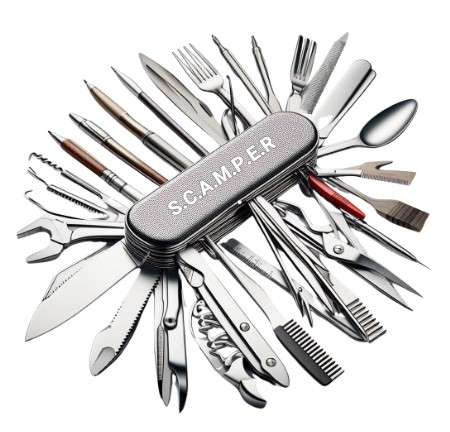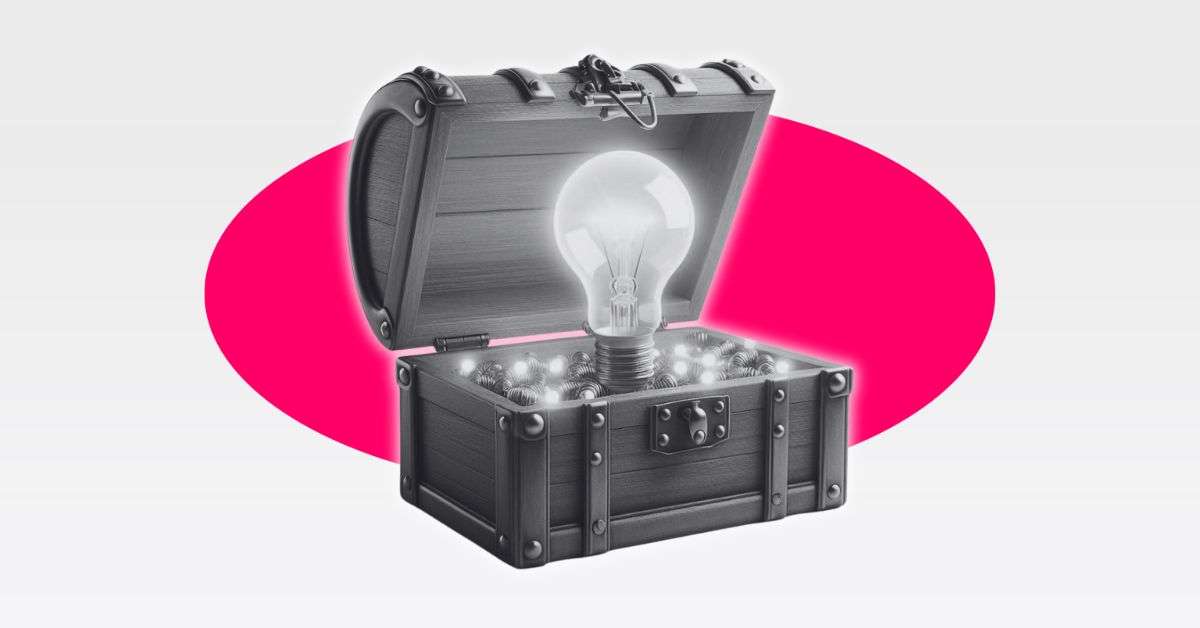The SCAMPER method is a highly effective creative thinking technique that has stood the test of time. In fact, it was first introduced by Alex Osborn in the 1950s, the very same person who gave us brainstorming. The SCAMPER method is an acronym that stands for Substitute, Combine, Adapt, Modify, Put to another use, Eliminate, and Reverse. It’s a great tool for solving problems, generating new ideas, and sparking innovation. Ready to learn more about it? All about Pros & Cons, Examples, and how to do it properly in under 5 minutes.
In a hurry? Jump to:
What is the SCAMPER Method?
The SCAMPER method is a structured approach to creative problem-solving and idea generation. It provides a set of seven techniques that can be applied to existing products, processes, or ideas to generate new and innovative solutions. Each letter in the word “SCAMPER” represents a different technique:
- S – Substitute: This technique involves replacing certain elements of a product or idea with something else. For example, you could substitute a traditional material with a more modern alternative.
- C – Combine: This technique focuses on combining different elements to create something new. It could involve merging two products or ideas to form a single, more powerful solution.
- A – Adapt: Adapting means to take inspiration from one context and apply it to another. You could adapt a feature from a completely unrelated product to improve your own.
- M – Modify: Modification involves making changes to the existing product or idea. This could mean altering its shape, size, color, or any other attribute.
- P – Put to another use: This technique involves finding new applications for an existing product or idea. Think about how you can repurpose it to serve a different function.
- E – Eliminate: Eliminating means removing certain elements to simplify the product or idea. By getting rid of unnecessary features, you can make the solution more streamlined and efficient.
- R – Reverse: Reversing involves looking at the problem from a different perspective. You could flip things around or turn the idea on its head to uncover new possibilities.
The SCAMPER method can be applied to a wide range of contexts, from product design and marketing to personal goal setting and creative writing. It is a versatile and powerful tool that can help you break out of your usual thinking patterns and unleash your creativity.
Pros & Cons

Like any other technique, the SCAMPER method has its own set of advantages and disadvantages. Let’s take a look at both to give you a better idea of what to expect when using this technique:
Pros:
- Creative approach: The SCAMPER method provides a structured yet creative approach to problem-solving and idea generation. It encourages you to think outside the box and come up with innovative solutions.
- Seven different techniques: The method offers a variety of techniques to choose from, allowing you to tailor your approach to the specific problem at hand.
- Proven track record: The SCAMPER method has been used successfully by countless individuals and organizations to generate new ideas and improve existing products and processes.
- Easy to learn and apply: The concept behind the SCAMPER method is simple and easy to understand, making it accessible to people of all backgrounds and skill levels.
- Encourages collaboration: The method can be used in a group setting, fostering collaboration and the exchange of different perspectives.
Cons:
- Overcomplication: In some cases, the use of the SCAMPER method can lead to overcomplicating a solution or idea by introducing unnecessary changes.
- Lack of originality: If not used carefully, the method can result in ideas that feel forced or lack true originality.
- Requires practice: While the basic concept is easy to grasp, mastering the SCAMPER method and using it effectively may require some practice and experience.
- Not a one-size-fits-all solution: The method may not be suitable for every type of problem or creative challenge, and there are situations where other approaches might be more effective.
You can read more about how SCAMPER training significantly increased TCT-DP scores in this study.
No worries, our team’s here to help, and there’s zero obligation. Reach out today!
When to use the SCAMPER method
The SCAMPER method is a versatile tool that can be used in a variety of situations. Here are some examples of when to use it:
- Product development: Use the SCAMPER method to generate new ideas for product features, improve existing designs, or create variations of a product.
- Marketing: Apply the method to develop creative marketing campaigns, design new advertisements, or rebrand a product.
- Problem-solving: Use the method to find innovative solutions to complex problems or challenges.
- Creative writing: Apply the SCAMPER method to spark new ideas in your writing, develop interesting characters, or create captivating storylines.
- Process improvement: Use the method to optimize and streamline existing processes, identify inefficiencies, and generate new ways of working.
- Education: Incorporate the SCAMPER method into your teaching to encourage creative thinking and problem-solving skills in your students (see also: team building for students).
In general, the SCAMPER method is most effective when you are looking to generate new ideas, improve existing solutions, or break out of a creative rut. It can be used both individually and in a group setting, making it a valuable tool for personal and professional development.
SCAMPER Examples
To give you a better understanding of how the SCAMPER method works in practice, let’s look at some real-life examples:
Substitute
A company that produces plastic water bottles is concerned about the environmental impact of its products. They decide to substitute traditional plastic with a biodegradable alternative, such as PLA (polylactic acid).
Combine
A restaurant wants to create a unique dish that will set it apart from the competition. They decide to combine two popular foods – pizza and sushi – to create a new and innovative menu item: the “sushi pizza” (we strongly distance ourselves from such a creation).
Adapt
A smartphone manufacturer takes inspiration from the camera industry and adapts the concept of interchangeable lenses. They apply this idea to their smartphones, allowing users to attach different lenses to enhance their photography.
Modify
A furniture designer wants to create a more versatile and space-saving table. They modify the design of a traditional dining table, adding folding and extending mechanisms to make it adjustable and suitable for small spaces.
Put to another use
A company that produces industrial drones for aerial photography realizes that their drones can be put to another use. They repurpose them for inspecting and maintaining wind turbines, saving time and reducing the risk for workers.
Eliminate
A software developer wants to simplify their app and make it more user-friendly. They decide to eliminate unnecessary features and buttons, focusing on the essential functions to improve the overall user experience.
Reverse
A crowdfunding platform reversing its business model: Instead of individuals seeking funding for their projects, they create a platform where investors pitch their ideas or business proposals to a community of potential backers, who then choose which projects to fund.
These examples demonstrate how the SCAMPER method can be applied in various industries and contexts to generate new ideas and solutions. By using the different techniques creatively, you can unlock innovation and drive positive change.
6 Tips for Using the SCAMPER Method
To make the most of the SCAMPER method, consider the following tips:
- Understand the problem: Before applying the SCAMPER method, make sure you have a clear understanding of the problem or challenge you are trying to solve. This will help you choose the most appropriate technique and focus your efforts.
- Use multiple techniques: Don’t limit yourself to just one technique. Experiment with multiple SCAMPER methods to uncover a wide range of ideas and possibilities.
- Take your time: Creativity can’t be rushed. Give yourself and your team enough time to explore ideas thoroughly and let the creative process unfold.
- Keep an open mind: The SCAMPER method is all about thinking creatively and breaking out of conventional thought patterns. Keep an open mind and be willing to explore unconventional ideas.
- Seek feedback: Share your ideas with others and seek feedback. The input of your colleagues or peers can help you refine your ideas and identify the most promising solutions.
- Document your ideas: Keep a record of the ideas you generate. This will allow you to review and revisit them later, and it may also inspire new ideas in the future.
Conclusion
The SCAMPER method is a powerful tool that can help you unleash your creativity, solve problems, and generate innovative ideas. By understanding the different techniques, and applying them effectively, you can breathe new life into your projects and work. Remember, the key to success with the SCAMPER method lies in practice, patience, and a willingness to think outside the box. So, go ahead and start using the SCAMPER method today to unlock your creative potential and take your endeavors to new heights!




